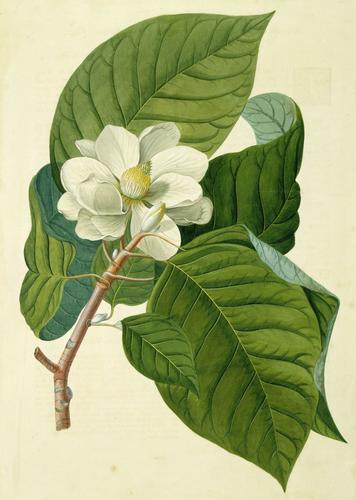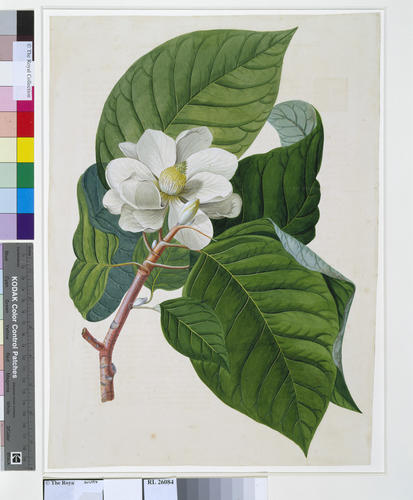Magnolia flore albo c.1736-47
Watercolour and gouache heightened with gum arabic, over graphite | 40.5 x 29.3 cm (sheet of paper) | RCIN 926084
-
A watercolour of a sprig with broad, deep green, pointed leaves and a large, white flower and a bud.
Beginning in 1712, the English naturalist and amateur artist Mark Catesby made a series of expeditions to the British colonies in North America for the purpose of documenting the indigenous flora and fauna which, as he put it, ‘were Strangers to England’. His resulting book, the first on its subject, was The Natural History of Carolina, Florida and the Bahama Islands, issued in parts between 1729 and 1747. The book is an extraordinary visual record of the plants, mammals, lizards, snakes, insects, corals, fish and birds which he found on his travels. These are original watercolour drawings for the illustrations. The celebrated German botanical illustrator Georg Dionysius Ehret was invited to contribute illustrations to Catesby’s Natural History. This watercolour actually depicts two different species of magnolia - the leaf of the cucumber tree (Magnolia acuminata) with the flower of the sweet bay (Magnolia virginiana) - suggesting that specimens had become separated en route from Virginia to England and were then incorrectly matched up. Unlike Catesby, Ehret did not visit North America. In the etched plate Catesby added a velvet ant to the image, borrowed from a page of his own insect studies.
Catesby dedicated the first volume of his work to Queen Caroline, consort of George II, and the second to Augusta, Princess of Wales, the mother of George III. Both were keen amateur botanists, and the Princess of Wales may be seen as the founder of Kew Gardens. When George III acquired a unique three-volume set of Catesby’s Natural History from a London dealer, Thomas Cadell, in 1768 he may already have known the published work. In this set the engraved plates were replaced by the preparatory watercolours on which Catesby based his plates. The colours in the 263 watercolours - protected from the light - have remained extraordinarily fresh. Following an extensive conservation campaign in the 1990s, involving both watercolours and bindings, the watercolours have now been separately mounted, and their places in Catesby’s volumes have been taken by facsimile reproductions, made by Alecto Historical Editions.
Catalogue entry adapted from George III & Queen Charlotte: Patronage, Collecting and Court Taste, London, 2004Provenance
Thomas Cadell; from whom bought by George III, 1768
-
Creator(s)
Acquirer(s)
-
Medium and techniques
Watercolour and gouache heightened with gum arabic, over graphite
Measurements
40.5 x 29.3 cm (sheet of paper)
Other number(s)
RL 26084Alternative title(s)
Magnolia flore albo









